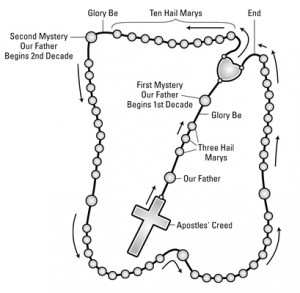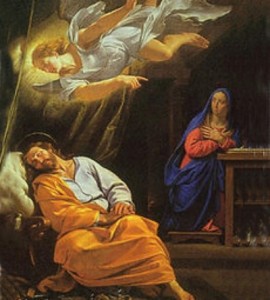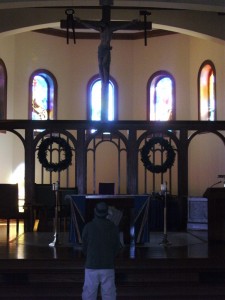I’ve got a thing for meditation/prayer beads. It all started in January when I began meditation on a string of 108 rudraksha beads, said to be sacred to Lord Shiva. Ever since, I’ve looked for them each month.
Catholicism doesn’t disappoint.
The rosary comes from the Latin word rosarium meaning “rose garden” or “garland of roses.” Each bead on the rosary therefore symbolizes offering a bouquet of prayers to the Virgin Mother.

Use of the rosary originated in the Middle Ages as a way for parishioners (usually illiterate) to recite prayers privately on their own. According to Church tradition, the rosary was given to Saint Dominic in a vision of the Blessed Virgin Mary in 1214. Meditative practices using the rosary were propagated by Dominic of Prussia who called it the Life of Jesus Rosary.
Indeed, though the rosary consists of a “Hail Mary” prayer for each bead within each decade, the focus of the meditation is on the mysteries of Christ’s life. The Hail Mary prayer is actually based on the visitation of the angel Gabriel to Mary in the beginning of the Gospel of Luke, therefore the prayer is basically a recitation of Scripture.
A full rosary (usually worn and utilized by those in religious/monastic communities) consists of 20 decades (groups of 10 beads) which are then divided into four groups of five decades each. Each of the four groups are designated a “mystery” pertaining to Christ’s or Mary’s life. Those mysteries are:
The Sorrowful Mysteries:
Jesus’ agony in the garden
His scourging at the pillar
The crowning of thorns
Carrying the cross
The crucifixtion
The Joyful Mysteries:
The annunciation (Jesus’ conception)
The visitation (Mary visits Elizabeth)
The birth of Christ
Jesus presented at the Temple
Finding Jesus teaching at the Temple (age 12)
The Glorious Mysteries
The resurrection of Christ
The ascension of Christ
Descent of the Holy Spirit (Pentecost)
Assumption of Mary into Heaven
Crowning of Mary as Queen of Heaven
The Luminous Mysteries
Baptism of Jesus
Wedding Feast at Cana
Jesus proclaims the Kingdom of Heaven and calls all to repent
Christ’s transfiguration
Institution of the Eucharist (Last Supper)
These are the mysteries one contemplates as the beads of the rosary move through one’s fingers. A “standard” rosary like mine and most Catholics’ have only five decades and therefore the mysteries are contemplated at different times during the week or whenever one chooses. The formation of the prayers, which include the Apostle’s Creed at the crucifix, “Our Father (the Lord’s Prayer)”, “Hail Mary” on each decade bead, and “Glory to the Father.”
Here is an image of praying the rosary from the “Dummies” series:
 It looks and sounds more difficult than it really is. My eyes crossed at first when learning how to pray the rosary, but once I memories the short prayers, it was pretty straight forward.
It looks and sounds more difficult than it really is. My eyes crossed at first when learning how to pray the rosary, but once I memories the short prayers, it was pretty straight forward.
The purpose of the rosary isn’t to add yet another pious responsibility upon the faithful, but to serve as a meditative tool which brings us closer to Christ. We are spending time with Jesus during the rosary as we literally revisit his life and ministry in our hearts and minds.
“Meditation engages thought, imagination, emotion, and desire. This mobilization of faculties is necessary in order to deepen our convictions of faith, prompt the conversion of our heart, and strengthen our will to follow Christ…This form of prayerful reflection is of great value, but Christian prayer should go further: to the knowledge of the love of the Lord Jesus, to union with him.” Catechism of the Catholic Church, paragraph 2708
Meditation on Christ, in this way, was something I was never taught as a Protestant. That isn’t to say that Protestants are ignorant of this method, but that I simply wasn’t given this tool. Perhaps it was because of its Catholic association, and I therefore deemed it guilty of heresy. What I do know is that because of the rosary, because of this method of lectio divina (“divine reading”), of entering Christ’s peace by meditatively fusing one’s self with his life, I can see Jesus this month in ways I’ve never experienced before. Jesus becomes the man who is fully God and not just the cause of my condemnation.

I’ve heard that many Catholics groan at the thought of praying the rosary. It’s long, it’s tedious, and it’s boring. Boring…I hear that a lot this month too. Perhaps I don’t see the boredom because I’m fresh at Catholicism. Perhaps I’m not bored because I’m neck deep in a whole new world. Deep down though, I think it’s something else. I think my enthusiasm for the faith (as well as others) stems from the same passion that makes saints who they are: memorable, combustible by God, passionate, alive in Christ. Why is it that these folks were willing to die for God and the Church? Why were they willing to go to any clime and place to preach the “good news”? I’m sure it wasn’t because they were bored and wanted something exciting to do…
Catholics, when was the last time you prayed the rosary? What does it mean to you? Protestants, given the nature and purpose of the rosary, do you think this could become a meaningful part of your meditation on Christ? Everyone else, do you have a prayer or meditation life that utilizes beads? What is your experience like?

